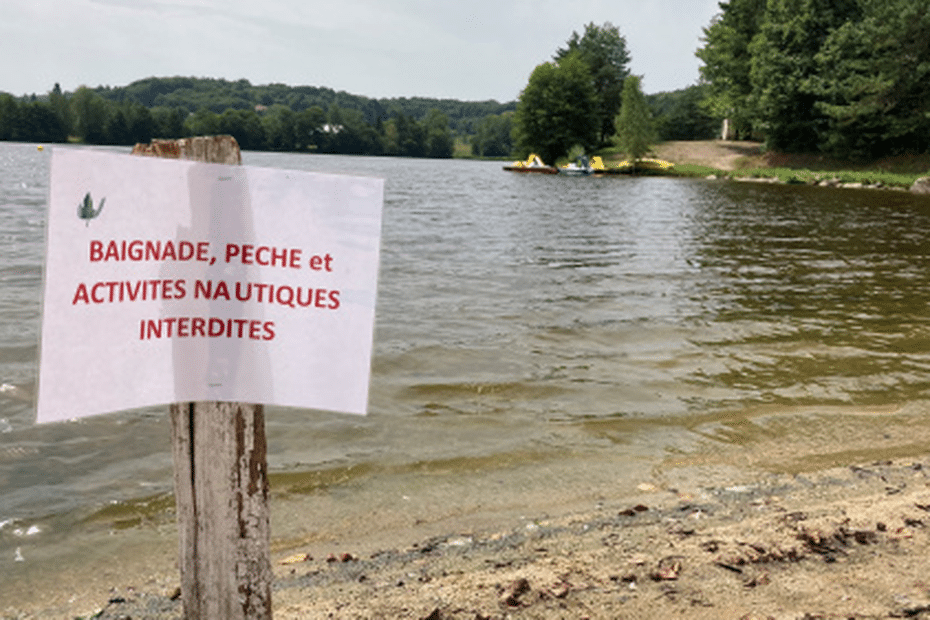Several water points are currently closed due to excessive proliferation of these “blue algae” which sometimes produce toxins that are dangerous for humans. Three questions to learn more about these cyanobacteria.
Bathing bans have followed one another in recent weeks. The bathing area in the Vienne at Bonneuil Matours, the water bodies of Tarnac, Coiroux or even Saint-Cyr… all are affected by proliferations of the same type: those of cyanobacteria. When present in excessive quantities, these micro-organisms can be toxic to humans and animals.
What is a cyanobacterium?
It is a prokaryotic micro-organism (that is to say with cells without a nucleus) which has the particularity of producing bluish photosynthetic pigments – like its name, cyan, indicates. This is why they are commonly called the “blue algae“although they are not really algae which do have a nucleus (family of eukaryotes).
Cyanobacteria are part of dhe oldest organisms on Earth: their origin is dated between 2.7 and 3.5 billion years ago. “Life on Earth would be very different if cyanobacteria weren’t there.”, says Benjamin Marie, researcher at the CNRS. The specialist in these bacteria deplores a lack of public knowledge of these organisms. “We talk about them when they prevent us from swimming, but they don’t only have harmful aspects.”
We owe cyanobacteria to have oxygen in the air. Indeed, they carry out oxygenic photosynthesis: by fixing the carbon dioxide (CO2) present in the air and by releasing dioxygen (O2), they transform solar energy into chemical energy (sugars).
Cyanobacteria — organisms whose origin dates back 3.5 billion years — are not only harmful, they also carry out photosynthesis. • © Clara Robert-Motta / France 3 Poitiers
Why is there an increase in cyanobacteria in our water bodies?
If cyanobacteria proliferate, they can. As soon as they have the necessary light and food, these micro-organisms multiply. However, many human activities, linked to our lifestyles, provide them with a large quantity of all the nutrients they crave. This is called eutrophication.
Nutrient-generating activities include: l’agriculture which rejects a lot of phosphate and nitrogen (via fertilizers), but also the Wastewater. Especially during the tourist season, when the number of people in a given territory increases. It is not uncommon for wastewater treatment plants not to be sized for these additional inflows. This increases the risk of untimely discharges and the quantities of nutrients flowing into watercourses.
L’soil artificialization, in other words excessive concreting, prevents the nutrients from being well distributed in the soil. “Vegetation cannot act as a filter, and nutrients will not be retainedexplains Benjamin Marie. All the nutrients will end up in the same place — the river, the body of water — and in excess.”
“In general, the mode of production of our societies is to blame. We produce too many discharges. We should rethink our use of watersheds as a whole.”
Benjamin Marie, microbiologiste au CNRS-MNHN
On top of that, the global warming doesn’t make things better. Indeed, a higher temperature favors the development of cyanobacteria which are more active in these periods of high heat. No luck for us, the small lakes and water points in which we like to bathe are generally shallow and thus warm up more quickly. We can say that it is the cyanobacteria which “win“usually competition with other photosynthetic organisms that can develop there.
Are cyanobacteria dangerous?
Again, cyanobacteria are not inherently bad. What poses a problem is their presence in too large a quantity. When their quantities exceed a certain limit, what they produce can be dangerous.
Some species of cyanobacteria are toxigenic, that is, they produce toxins. If the measurements of these specific types of cyanobacteria or the toxins produced are too high, regional health agencies take action. This was particularly the case in the leisure park of Bonneuil-Matours (Vienne), this Wednesday, July 19. Philippe Vansygel, head of the health and environment department at the ARS de la Vienne explains: “We found the presence of toxoids which are neurotoxic and which can therefore attack the nervous system a little. This is why we prefer to prohibit swimming.“
Irritation of the skin, nose, throat… the symptoms can be mild, but if the concentration of toxins is too high, the damage can be more serious: diarrhea, vomiting, fever or tremors. Some doses of toxins can even be deadly, also for our pets. Hence the bans.
But we should not forget the animal damage and loss of biodiversity that these proliferations of “blue algae” induce. First effect: when there are too many cyanobacteria and these degrade, the water is no longer sufficiently oxygenated — we say that there is anoxia. “Even if photosynthesis produces oxygen, the biomass of cyanobacteria produced during blooms is rapidly degraded by bacteria that will consume this oxygen.“, specifies Benjamin Marie. This lack of oxygen can lead to the suffocation of fish and other organisms present in waterways and ponds.
The proliferation of cyanobacteria is favored by human activities that increase the level of nutrients in water bodies. • © Clara Robert-Motta / France 3 Poitiers
How to stop this proliferation?
The only solution would be to cut off the supply of these cyanobacterial blooms. For the National Agency for Food, Environmental and Occupational Health Safety (ANSES), there is only one possible conclusion. “There reduction of phosphorus and nitrogen inputs to surface waters remain today only sustainable way to protect and/or restore these ecosystems against planktonic cyanobacterial blooms“.
#Bathing #ban #cyanobacteria #proliferate


